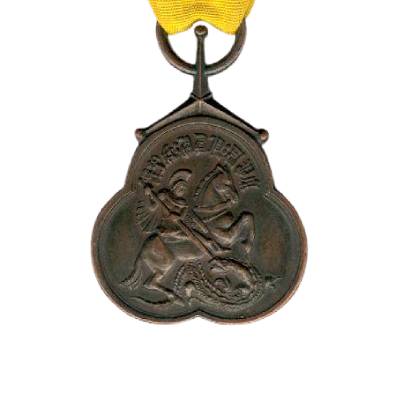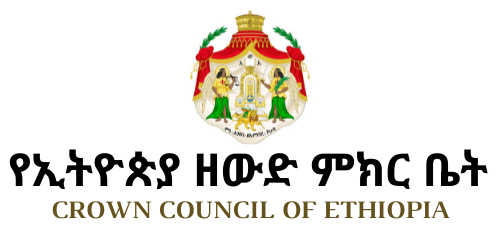
The Military Medal of Merit of the Order of St. George, sometimes referred to merely as the Military Medal of St. George, or the Medal of Merit of St. George, is the premier decoration for military service available to the Crown. The Military Medal of Merit replaces, and basically grew out of, the Military Medal of Menelik II, created in 1901-1902 by Emperor Menelik II. It was worn by the first Duke of Harar first in order of precedence of his medals, followed by the Distinguished Military Medal of Haile Selassie the First [see below]. The Duke’s decoration was the result of his extensive and highly successful military service against the Italians during the 1935-1941 War. He received the decoration twice (hence the bronze palm leaf on the riband).
The Crown Prince at the time (later Emperor Amha Selassie I), Asfa Wossen, also received the Military Medal of Merit of the Order of St. George, which he wore 10th in order of precedence on his riband bar, wearing the Distinguished Military Medal of Haile Selassie the First in eighth place.
It is not known whether the medal was ever awarded to any foreign nationals, but under the Chancery rules, there is nothing which precludes this. The Military Medal of Merit of the Order of St. George is for outstanding military service, including acts of extreme gallantry or for distinguished leadership during hostilities, and is awarded very rarely. None have been issued since the death of Emperor Haile Selassie.
The medal is bronze in the form of a trilobe, with the obverse showing St. George slaying the dragon, surrounded by text in Ge’ez. The medal is linked by a Trinity (three-pointed) star to a loop which attaches to a riband which is broken horizontally into two equal colours. Where a “bar” is awarded to the medal — that is, the recipient is awarded the medal for a second time — a bronze palm leaf is affixed to the riband at the joining point of the two colours. Holders of the decoration may use the post-nominal initials MMM.


